ENRON: The Road To Jail for Key Lay
and
Jeffrey Skilling.:

source: http://institute.ourfuture.org/corporate-wilding
Greed and Opulence, The Fast Lane,
Pals with The President,
MassiveAccounting Fraud,
Endless Lies to The Public, Insider
Trading,
Margin Calls, Bankruptcy and 20,000 People Laid Off.
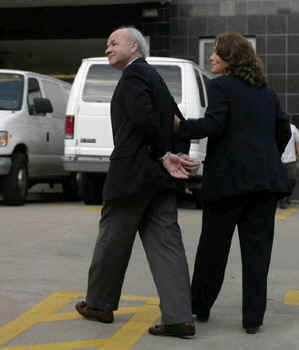
Before its
bankruptcy on December 2, 2001, Houson-based Enron
employed 20,000 and was
one of the world's biggest electricity, natural gas,
and communications
conglomerates. Its annual report said its revenues were
more than $100 billion
in 2000. Back then, Fortune magazine heralded
Enron as the
country's "most innovative" corporation.
Actually, Enron was
taking big advantage of de-regulation in the energy industry.
Its creativity was
mostly devoted to fabricating accounting illusions which
would pump up its
stock. All this amounted to wilful systematic defrauding
of shareholders for the
benefit of its insider trading chief executives, who
insisted on an opulent
corporate lifestyle no matter the consequences to
those it had a
fiduciary responsibility to protect, namely its employees
and shareholders.
Predictably, they were always very quick to dismiss with
prejudice all
criticism of opaqueness of their earnings reports.
Enron's CEO was a
George Bush Jr. pal, Ken Lay. Its Chief Financial Officers
were Jeff Skilling and
Andrew Fastow. This trio arranged to have assets
and profits regulalry
inflated while placing many debts and losses into
off-shore limited
partnerships, so that they would never make their way
into the firm's
financial reports. Off-shore, these entitites could also
escape US
taxation. The falsifications grew each year because the company
needed to show good
growth to satisfy Wall Street and keep its shares rising
so that the insiders
could sell their own holding at top dollar and Enron
could keep using its
own shares to buy other companies.
When Skilling became
CEO, it became common practice for Enron to record
anticipated
trading gains from its energy wholesaling and trading operations
as actual
gains. The illusion of growth could only be kept alive while the
economy was growing and
investors remained optimistic. When a Wall Street
analyst dared question
Skilling's failure to provide an intelligible balance sheet
with his earnings
report, Skilling called him an "asshole and was applauded
by fellow Enron
executives.
(Source: Beth MacLean and Peter Elkind, Smartest
Guys in the Room:
The Amazing Rise
and Scandalous Fall of Enron, 2003 )
ENRON's Peak in 2000.
2000 saw the peak
in Enron's stock. Investors were told the stock would soon
be over $100. In
addition, Ken Lay had helped boost George Bush Jr. to the
Governorship in Texas
in the 1990s. So, it was expected the new President
would be helpful to
Enron's fortunes. Because of these high hopes, Enron's stock
still performed better
than the DJIA in late 2000 as George Bush was made
President by the
Supreme Court. .
TigerSoft's
Opening and Closing Power showed Enron regularly rose at the
openings only to fall
back at the close. This we call "Public Buying" and
"Professional
Selling." This pattern is usually bearish since the less informed
public is more likely
to buy emotionally at the openings based on public news
stories.
Professionals, on the other hand, make use of the entire trading day.
In this way, their
larger sized orders can be worked into the market.
We can also guess that
the market makers and NYSE Specialist in the
stock were
regularly boosting the stock at the beginning of the day where
they could short it.
They then let it fall off during the rest of the trading day.
Early Warning: Rising Opening Power and Closing Power
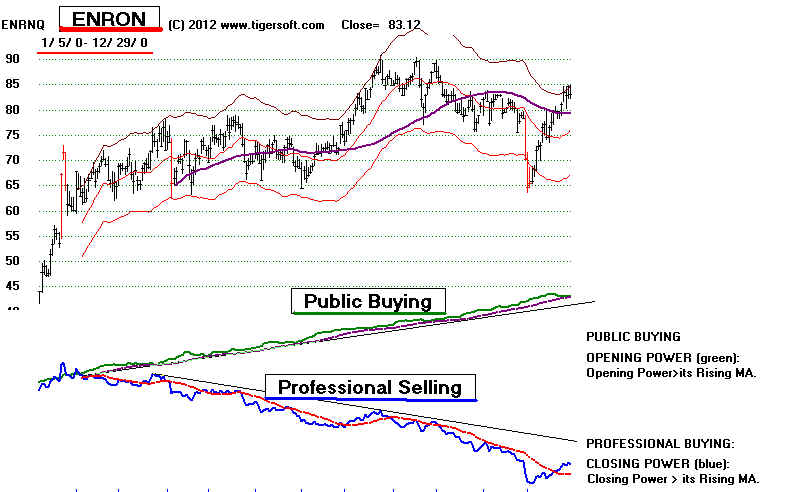

Tiger Day Trader's Tool (DTT)
Traders use our
Tiger Day Trader's Tool to see whether there is more upside or
downside potential
each day in a stock. The slope of Enron's Day Traders' Tool
was dramtically
down. This showed it was profitable while the DTT was falling
to use leverage
and sell the stock short at the openng and then cover near the close.
The gains were
modest, but remember that day traders use 3:1 leverage frequently
and the stock was
still advancing rising for the year. Short positions would only have
been taken for
only about 25% of the entire year.
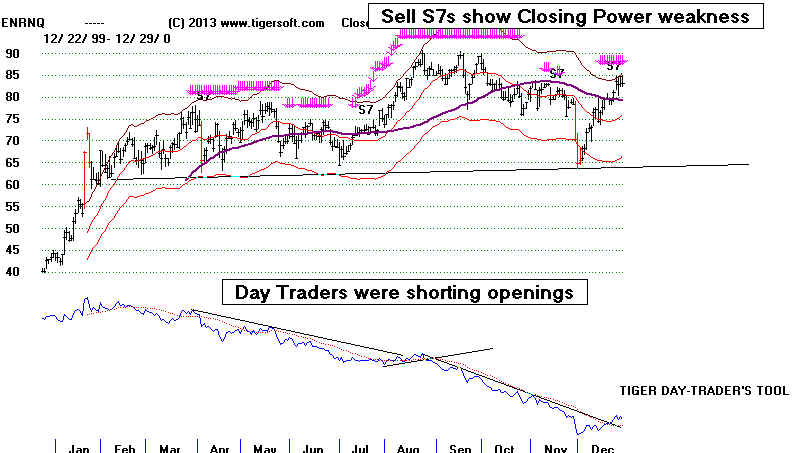
Bush's Innauguration in January 2001 Does Not Save Enron
Ken Lay, Enron's
founder, was one of George Bush Jr.'s biggest campaign
contributor and
supporter in Texas when he ran for Governor and when he
sought the
Presidency. (See materials at the end of this chapter.)
Enron's fraudulent
accounting, however, was too massive to be helped by any
help the new
President or VP Cheney could give in the form of deregulation and
intervention on
Enron's behalf when it was disclosed how Enron had rigged prices
Californians had
to pay for natural gas in the heat wave of 2001 using an assortment
phantom bids and
phoney trading accounts.
The stock market
topped out in 2000 and went into a long bear market until March 2003.
As the stock
market turned down in 2000 and then much more in 2001, institutional
investors became
more cautiou. They started to demand more transparent accounting
in the stocks they
were willing to hold. Enron's accounting had long been questioned
at a professional
level. In this environment more and more institutional clients began
to sell their shares
aggressively. We see this in the high volume red down-days on the
Tiger Soft
chart. In March 2001, the stock broke below its price support at 65.
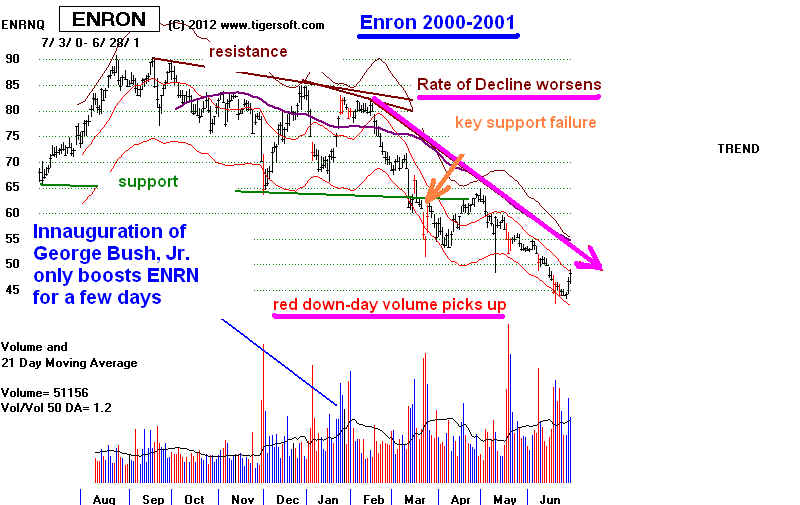
Steady Distribution, Insider and Professional Selling
Enron's
blue Closing Power in the chart TigerSoft chart below remained in a steep
angle
downward for the entire year after August 2000. Professionals were steady net
sellers.
See also the steadily negative (red) readings, often below the -.25 threshold,
from
the Tiger Accumulation Index for Enron, especially after March. We interpret
in
our charts to most commonly be a sign of continuous insider selling on any transient
price
strength the stock may show. The selling is not necessarily by the corporate
insiders
themselves, it can also be by those who notice the heavy selling by corporate
insiders
and their associates. It is difficult to conceal important insider selling very
long.
As a result, Enron's relative strength versus the blue chip DJIA made new
lows in
March
and the stock kept falling. See also the numerous Tiger technical warning on
the
chart.
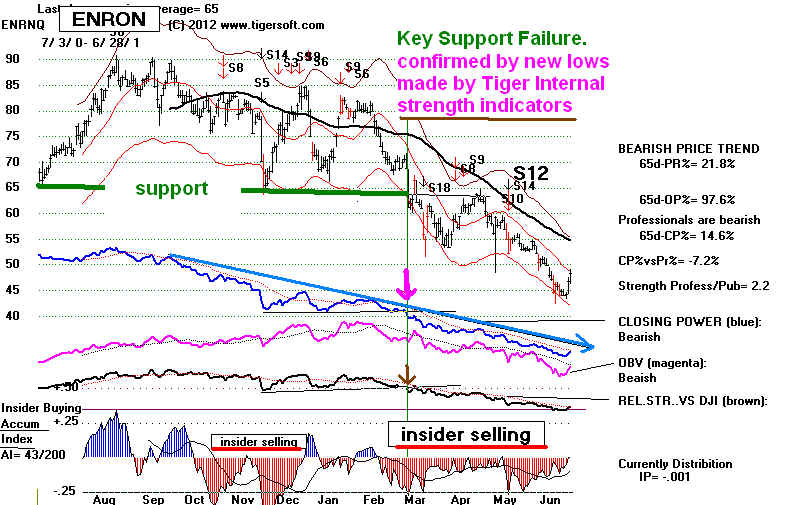
Bear Market Hits Enron Hard in 2001
In
May 2001, Tiger'S Peerless Stock Market Timing warned of a coming sell-off
with
its automatic Sell S4. The completion of a head/shoulders pattern showed
trouble
lay ahead. Ken Lay's margin account would soon be in big trouble. Lay
claimed
in his criminal defense trial in 2006 that 90% of his net worth was in Enron
stock,
but by 2001 he was 100 million dollars in debt. He maintained he only sold
his
Enron stock to meet tmargin calls. But, the truth was Lay did have other
alternatives
to borrowing from Enron and selling his company's stock. He had $50
million
in other credit lines besides Enron, non-Enron stock and real estate.
(
Source. ) Lay soon surrendered to temptation in 2001 amd sold million of
dollars
worth of Enron, all the while failing to mention to public shareholders
how
bad the accounting and the financial situation were at Enron.
Because
of a loophole in the law requiring timely reporting of sales of stock in
their
own company, Key Lay did not have to report his sales of Enron until the
end
of the calender year. The loophole was for those executive receiving margin
calls
from their stock broker.
(Source: http://www.fatpitchfinancials.com/314/tracking-insider-trading/
)
Bear Market
DJI
Sell-Off Started in May 2001 and ended in 2001 after 9/11 Attack of WTC
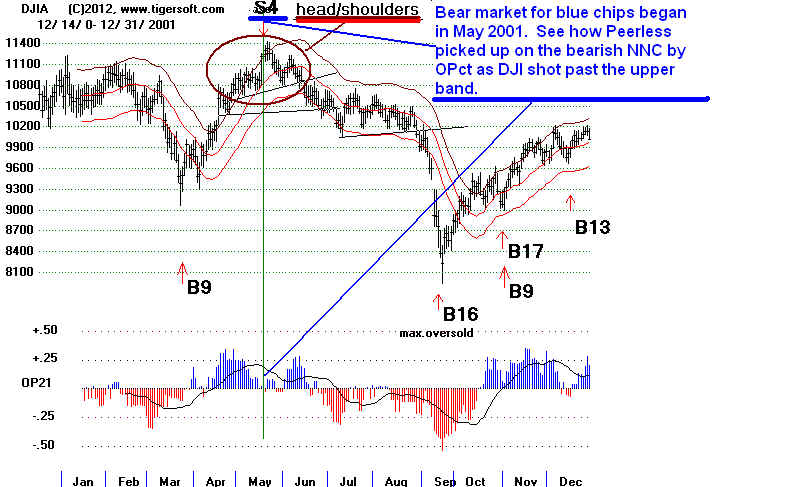
Enron's Complete
Collapse in 2001.
On August 14th, 2001,
Lay's protoge and hand-picked successor as Enron CEO,
Jeffrey Skilling,
suddenly resigned. He had been CEO for only six months. He was
to be paid $132 million
in the first year. Skilling had created EnronOnline,
an
Internet-based energy trading
operation, which became widely used but brought
notoriety to Enron as a
result of its rigged trading of electric power to California.
In the middle of the
brown-outs in late July 2001, Skilling was reported to have
quipped "What is
the difference between California and the Titanic? At
least
when the Titanic went
down, the lights were on." Upon quitting his post, Skilling
began dumping $60 million in
Enron stock on the market in blocks of 10,000 to
500,000. Prosecutors
used this to prove "insider trading", arguing that Skilling
knew of the impending
bankruptcy. In 2005, Skilling was found guilty of insider
trading, five counts of
making false statements to auditors and 12 counts of securities
fraud. He was sentenced to
prison for 24 years and fined $45 million.
Ken Lay then returned to
the post of Enron CEO. By then the stock was falling fast.
He still managed to sell
over $70 million worth of Enron stock. He used the
proceeds to meet margin
calls as the stock market fell sharply around the time
of September 11th attack
on the World Trade Center in New York. Lay's wife, Linda,
was accused of selling
500,000 shares of Enron stock totaling $1.2 million on November
28, 2001. Records
show that Mrs. Lay placed the sale order sometime between 10:00
and 10:20 am.
News of Enron's problems, including many millions of dollars in losses
that had been hidden fromt he
public was disclosed for the first time at about
10:30 AM. Soon after
that the stock fell below a dollar. Enron executive Paula Rieker
was also charged with
criminal insider trading. She had obtained 18,380 Enron shares
for $15.51 a share. She then
sold that stock for $49.77 a share in July 2001, a week
before the public was told
about an additional big Enron loss.
Three brokerage giants,
Merrill Lynch, JPMorgan-Chase and Citigroup were
accused by the SEC of helping
Enron inflate profits and conceal debts in 2001.
Merrill had in 1998 fired an
analyst for downgrading Enron, only to scoff at its
investors in private. Merrill
paid an $80 million fine ( Source.
) When the other
companies agreed to take
"corrective action" to prevent such actions in the future,
the charges were dropped. (Source. )
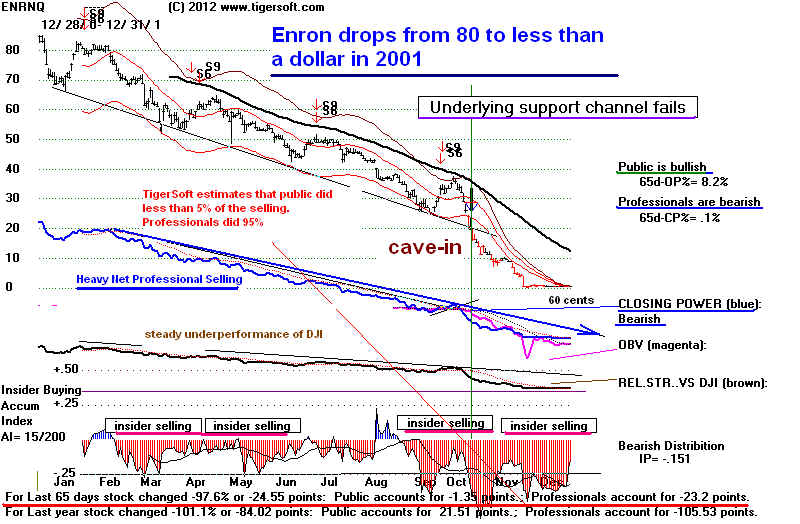


Ken
Lay on the Stand in his own defense in law court in 2006.
Lay "steadfastly refused to accept responsibility for any decision that might
have
contributed to the fall of Enron. Instead, he blamed Enron's troubles
on
a market panic caused by short-sellers, The Wall Street Journal, the bursting
of
the technology boom, the terrorist attacks of Sept. 11 and, most of all, the
schemes
hatched by the former chief financial officer, Andrew S. Fastow.

Kenneth
Lay, his wife and President George Bush
Convicted Enron swindler Kenneth Lay previously had helped
Bush enormously
in
raising campaign contributions. He gave "$122,500 to Bush Gubernatorial
campaign.
Lay had Enron give $50,000 to pay for Bush's second inaugural party
in
Austin in 1999 -- a showcase event that was organized by Karl Rove and others
to
help the Texas governor step onto the national political stage. Bush had given
Enron
exactly what it wanted in 1999, legislation that deregulated the state's
electrical
markets. From this, Lay knew he had found his candidate for president.
"When Bush opened his campaign, Lay opened the cash spigots. As a
"Bush
Pioneer" in the run-up to the 2000 presidential election, Lay was a key
member
of the Bush campaign's fund-raising inner circle. Under Lay's leadership,
Enron
ultimately gave Bush $550,025, making the corporation the Texan's No. 1
career
patron at the time the 2000 election campaign began, according to the
Center
for Public Integrity. Lay personally pumped almost $400,000 into Republican
hard-
and soft-money funds, while Enron slipped another $1.5 million into the GOP's
soft-money
cesspool.
"But that
was just the beginning. Lay sent a letter to Enron executives urging them to
contribute to Bush's campaign. More than 100 of them -- including Skilling, a major
Bush
giver since 1993, when he cut his first $5,000 check to GW's gubernatorial
campaign
-- did just that. Dozens of spouses wrote, including "homemaker" and
frequent
$10,000 donor Linda Lay, gave as well, making the Enron "family"
a
prime source of the money... All told, it is estimated that, over the
years
prior the company's bankruptcy, Lay, his company and its employees
contributed
close to $2 million to fund George W. Bush's political rise. Lay found
other
ways to help, as well. He put Enron's corporate jets at the disposal of the
Bush
campaign in 2000. He kicked in $5,000 to pay for the Florida recount fight,
while
a top Enron "consultant," former Secretary of State James A. Baker III,
ran
the Republican's recount effort. He even paid for his own bookkeeping,
chipping
in $1,000 to help the Bush-Cheney campaign comply with campaign-finance
laws.
And Lay and Enron gave $300,000 to underwrite the Bush-Cheney inauguration
festivities
in 2001.
(Read
- John Nichols, Nation article on the Lay and Bush connection.
http://www.commondreams.org/views06/0526-27.htm
)













